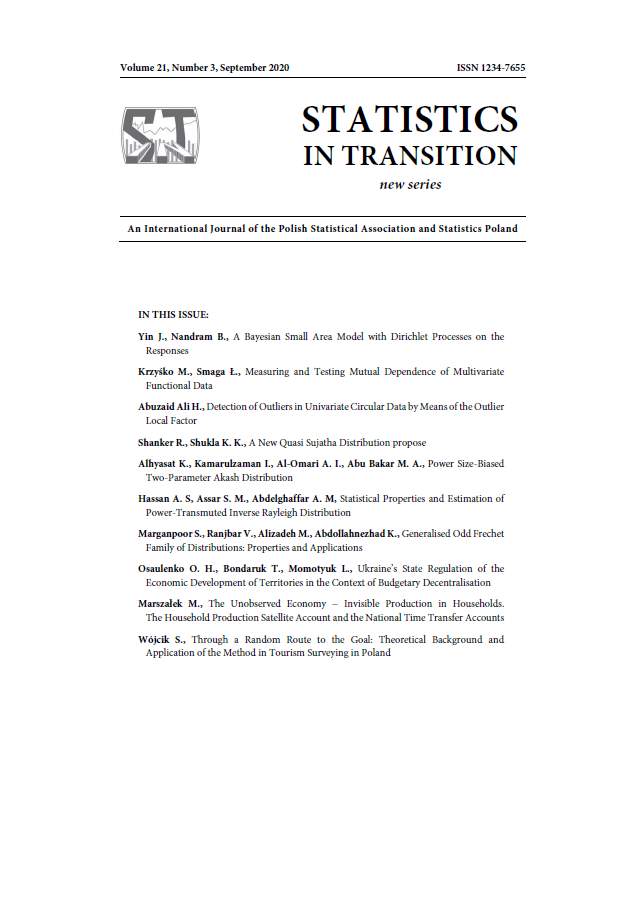ARTICLE
ABSTRACT
Typically survey data have responses with gaps, outliers and ties, and the distributions of the responses might be skewed. Usually, in small area estimation, predictive inference is done using a two-stage Bayesian model with normality at both levels (responses and area means). This is the Scott-Smith (S-S) model and it may not be robust against these features. Another model that can be used to provide a more robust structure is the two-stage Dirichlet process mixture (DPM) model, which has independent normal distributions on the responses and a single Dirichlet process on the area means. However, this model does not accommodate gaps, outliers and ties in the survey data directly. Because this DPM model has a normal distribution on the responses, it is unlikely to be realized in practice, and this is the problem we tackle in this paper. Therefore, we propose a two-stage non-parametric Bayesian model with several independent Dirichlet processes at the first stage that represents the data, thereby accommodating some of the difficulties with survey data and permitting a more robust predictive inference. This model has a Gaussian (normal) distribution on the area means, and so we call it the DPG model. Therefore, the DPM model and the DPG model are essentially the opposite of each other and they are both different from the S-S model. Among the three models, the DPG model gives us the best head-start to accommodate the features of the survey data. For Bayesian predictive inference, we need to integrate two data sets, one with the responses and other with area sizes. An application on body mass index, which is integrated with census data, and a simulation study are used to compare the three models (S-S, DPM, DPG); we show that the DPG model might be preferred.
KEYWORDS
Bayesian computation, bootstrap, predictive inference, robust modeling, computational and model diagnostics, survey data
REFERENCES
ANTONIAK, C. E., (1974). Mixtures of Dirichlet Processes with Applications to Bayesian Nonparametric Problems. The Annals of Statistics, 2 (6), pp. 1152–1174.
BATTESE, G. E., HARTER, R. M. and FULLER, W. A., (1988). An Error-components Model for Prediction of County Crop Areas using Survey and Satellite Data. Journal of the American Statistical Association, 83 (401), pp. 28–36.
BINDER, D. A., (1982). Non-parametric Bayesian Models for Samples from Finite Populations. Journal of the Royal Statistical Society, Series B, 44 (3), pp. 388–393.
BLACKWELL, D., MACQUEEN, J. B., (1973). Ferguson Distributions via Polya Urn Schemes. The Annals of Statistics, 1 (2), pp. 353–355.
ESCOBAR, M. D., WEST, M., (1995). Bayesian Density Estimation and Inference using Mixtures. Journal of the American Statistical Association, 90 (430), pp. 577–588.
FERGUSON, T. S., (1973). A Bayesian Analysis of Some Nonparametric Problems. The Annals of Statistics, 1 (2), pp. 209–230.
GELMAN, A., JAKULIN, A., PITTAU, M. P. and SU, Y-S., (2008). A Weakly Informative Default Prior Distribution for Logistic and Other Regression Models. Annals of Applied Statistics, 2 (4), pp. 1360–1383.
KALLI, M., GRIFFIN, J. E. andWALKER, S. G., (2011). Slice Sampling Mixture Models. Statistics and Computing, 21 (1), pp. 83–105.
LO, A. Y., (1984). On a Class of Bayesian Nonparametric Estimates: I. Density Estimates. The Annals of Statistics, 12 (1), pp. 351–357.
MOLINA, I., NANDRAM, B. and RAO, J. N. K., (2014). Small Area Estimation of General Parameters with Application to Poverty Indicators: A Hierarchical Bayes Approach. The Annals of Applied Statistics, 8 (2), pp. 852–885.
NANDRAM, B., CHOI, J. W., (2010). Bayesian Analysis of Body Mass Index Data from Small Domains Under Nonignorable Nonresponse and Selection. Journal of the American Statistical Association, 105 (489), pp. 120–135.
NANDRAM, B., CHOI, J. W., (2005). Hierarchical Bayesian Nonignorable Nonresponse Regression Models for Small Areas: An Application to the NHANES Data. Survey Methodology, 31 (1), pp. 73–84.
NANDRAM, B., CHOI, J. W., (2004). Nonparametric Bayesian Analysis of a Proportion for a Small Area under Nonignorable Nonresponse. Journal of Nonparametric Statistics, 16 (6), pp. 821–839.
NANDRAM, B., (2007). Bayesian Predictive Inference under Informative Sampling via Surrogate Samples. In Bayesian Statistics and Its Applications, edited by S.K. Upadhyay, U.Singh and D.K. Dey, Anamaya New Delhi, pp. 356–374.
NANDRAM, B., TOTO, M. C. S. and CHOI, J. W., (2011). A Bayesian Benchmarking of the Scott-Smith Model for Small Areas. Journal of Statistical Computation and Simulation, 81 (11), pp. 1593–1608.
NANDRAM, B., YIN, J., (2016a). Bayesian Predictive Inference under a Dirichlet Process with Sensitivity to the Normal Baseline. Statistical Methodology, 28, pp. 1–17.
NANDRAM, B., YIN, J., (2016b). A Nonparametric Bayesian Prediction Interval for a Finite Population Mean. Journal of Statistical Computation and Simulation, 86 (16), pp. 3141–3157.
NANDRAM, B., YIN, J., (2019). Hierarchical Bayesian Models for Small Areas With Dirichlet Processes. JSM Proceedings, pp. 2594–2613, Survey Research Methods Section. Alexandria, VA: American Statistical Association.
POLETTINI, S., (2017). A Generalized Semiparametric Bayesian Fay-Herriot Model for Small Area Estimation Shrinking Both Means and Variances. Bayesian Analysis, 12 (3), pp. 729–752.
RAO, J. N. K., MOLINA, I., (2015). Small Area Estimation, John Wiley & Sons, NY.
RUBIN, D. B., (1981). The Bayesian Bootstrap. The Annals of Statistics, 9 (1), pp. 130– 134.
SETHURAMAN, J., (1994). A Constructive Definition of Dirichlet Priors. Statistica Sinica, 4, pp. 639–650.
SCOTT, A., SMITH, T. M. F., (1969). Estimation in Multi-Stage Surveys. Journal of the American Statistical Association, 64 (327), pp. 830–840.
TOTO, M. C. S., NANDRAM, B., (2010). A Bayesian Predictive Inference for Small Area Means Incorporating Covariates and Sampling Weights. Journal of Statistical Planning and Inference, 140, pp. 2963–2979.
